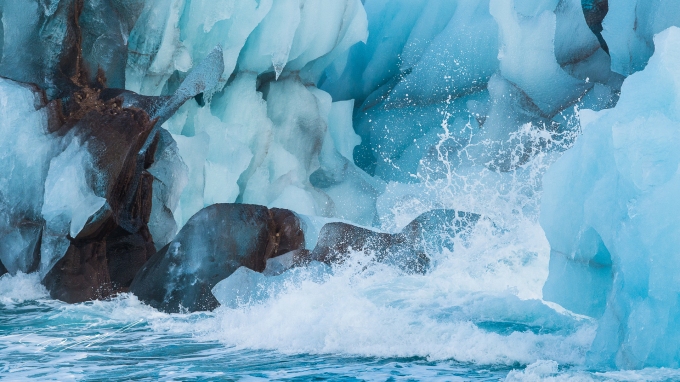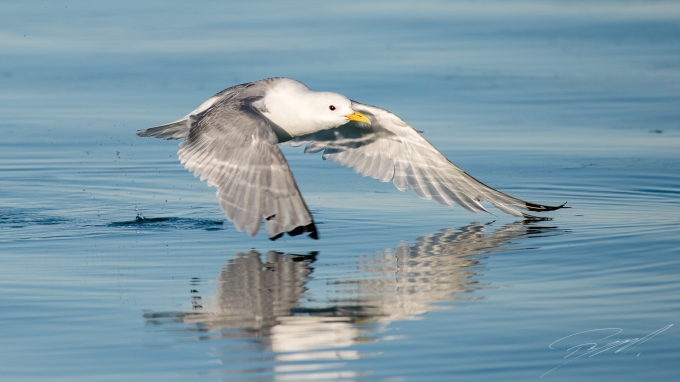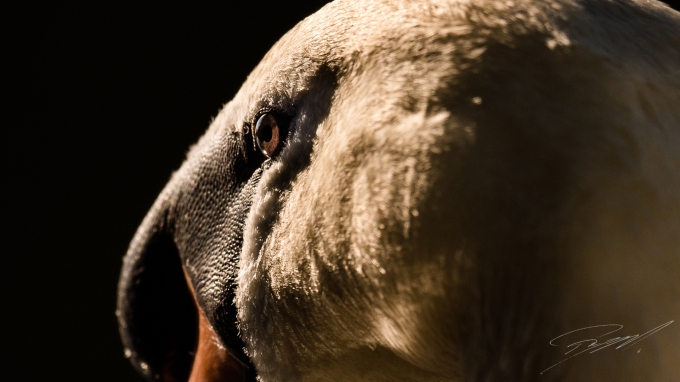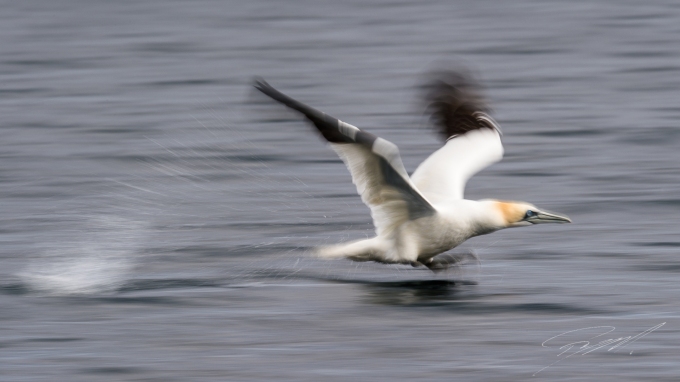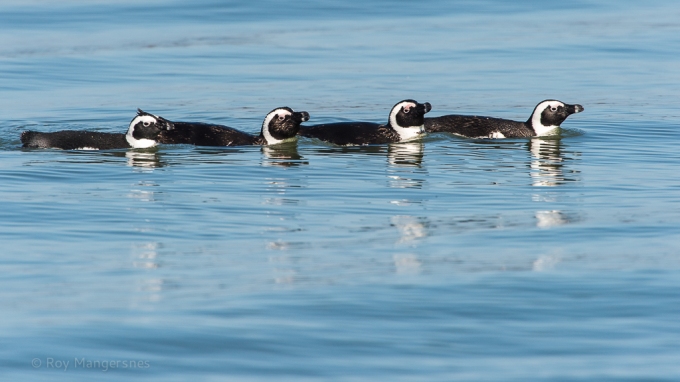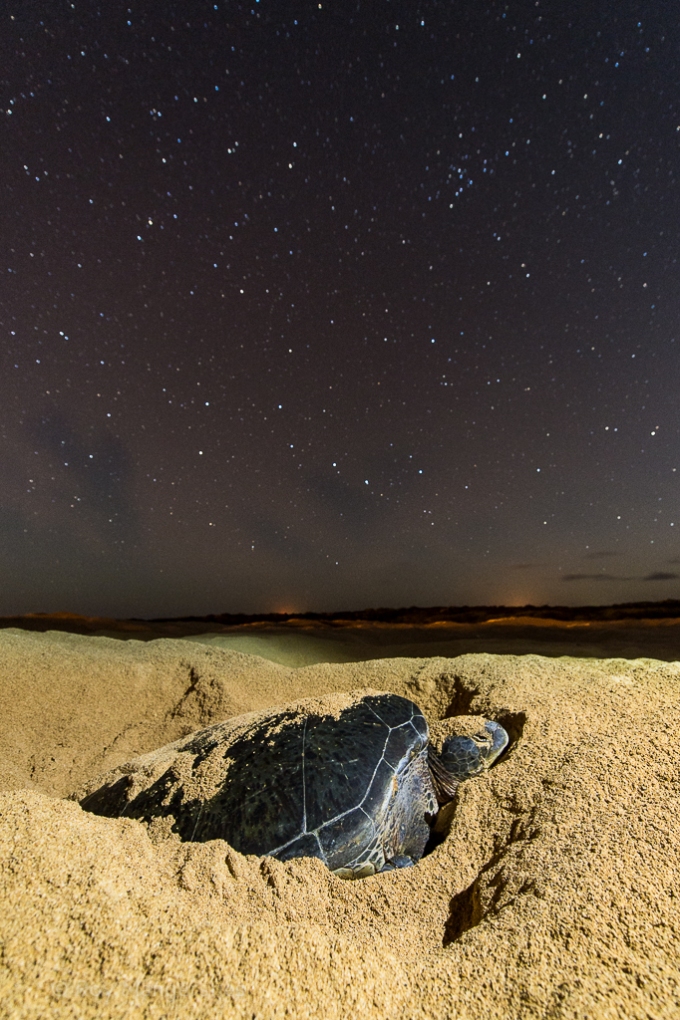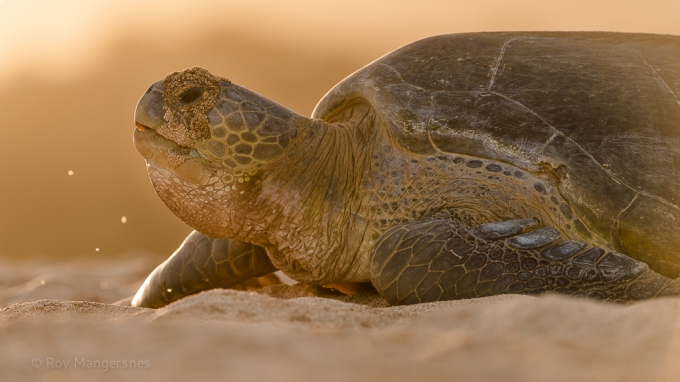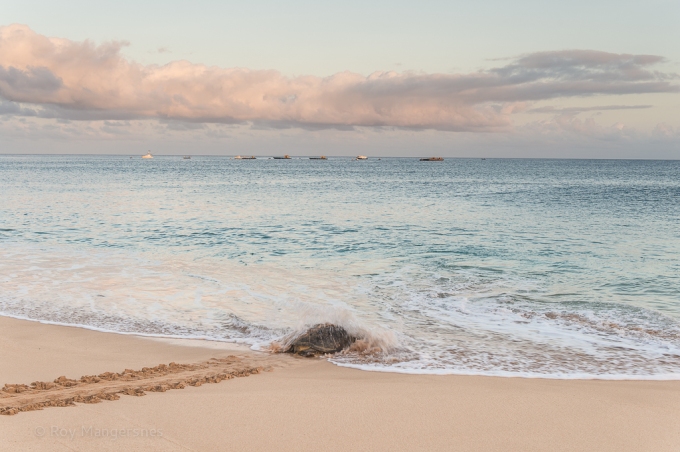Why I changed to Sony
Posted on November 22, 2019
I started my career as a Canon shooter, and moved to Nikon in 2009 when I got to try the D3 and the D3x. From then onwards I have been very happy with my Nikon gear and I was even lucky to represent the brand as an ambassador for 7 years. However, I have seen a change over time that made me start rethinking my choice of gear. In November 2019 I moved over to Sony and after using my new tools in Antarctica for 2 weeks, hosting a expedition with WildPhoto Travel, I have some thoughts I want to share.
Firstly I want to say that I am a true believer that the camera gear is not the most important tool to become a good photographer. Some people can create stunning images with a mobile phone. However I do believe that a good photographer, that knows how to utilize the tools available can improve his or her images by choosing the best available technology.
I also want to make it clear that I am not sponsored by Sony in any way, nor do I have any working relationship with the brand. I am however sponsored by Stavanger Foto that also sponsored my Nikon gear ever since I was relieved from my ambassador contract with Nikon Norway. Please check them out at www.stavangerfoto.no.

Shooting an Antarctic sunset with a mobil phone is also an option. Sony A7iii, 24-105/4, 1/160 sec, f/5 @ ISO 200.
So why change? To sum it up – innovation! Nikon has an amazing history of professional cameras and lenses that have been producing stunning images over decades. However, every time they have tried to take a leap into the mirrorless future they have failed, lately with the Z7 and Z6 that was released long before it was ready for the marked in my opinion. Amazing files, but completely useless autofocus from a camera manufacturer that is know to have one of the best focus systems in the world. And lets not even talk about the V1 series…
The only thing holding me back before has been the lack of Sony prime telephoto lenses, but now with a 400/2,8 and the 600/4, as well as a great selection of flexible lenses in the medium and wide range I don’t see why I shouldn’t take the leap. I already have several colleagues that have moved to mirrorless, and especially the Olympus system has been getting a lot of attention in Norway, but in my opinion it is not even close to the competition unless you are looking for a lightweight backpack. At least not for the kind of wildlife photography I am doing, and in the environment that I normally work.
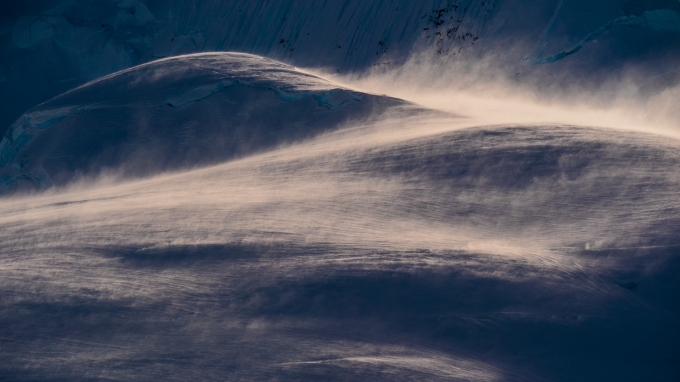
Most of my photography is done in the Arctic or Antarctic cold and windswept environment. Sony A9, 600/4, 1/2000 sec, f/8 @ ISO100
Lets start with the positives
My current field collection consists of a Sony A9 with a battery grip and a A7 III (while waiting for a A7r IV) with a 600/4, 70-200/2,8, 24-105/4, 16-35/4 and the brilliant 85/1,8. Weight has not really been a big issue for me, but I must admit it was a bit comforting to put my camera bag on the scale at the airport in Argentina and only get an approving nod from behind the counter. The bag weighed in at 12,5 kg, oppose to close to 20kg with my old system. Stress level reduction – check!
Then let’s jump straight into it; the focus system – wow! I have always believed that Nikon has the best focus system in the world, but I will be the first (I think) to admit I was wrong. The flexible tracking spot of the Sony A9 is completely mind-blowing. I still think that my Nikon D5 caught the subject faster while it was still small in the frame, and especially in hard backlight, but when the A9 has the subject locked it just doesn’t let go. While shooting Antarctic cormorants flying to the nest at high speed I shot 2200 backlit images in two hours with my 600mm and ALL of them where in focus. Because the birds came in very close I did cut the wings, head or tail at times, but even when just the tip of a wing was in the viewfinder it was a sharp wingtip. The Sony sensor has focus points on 100 % of the viewfinder and it really makes a difference.
During the cormorant shoot I was firing at continuous high and medium with electronic shutter, giving me roughly 14 frames per second with uncompressed RAW. I realized that the mechanical shutter was useless for this kind of shooting and I honestly don’t see why you would bother using it unless you need a long exposure. I guess that is the only reason it is even an option. I was also using a small spot to lock onto the bird while it was still small in the frame. In addition I have my camera set to medium lock-on and I noticed on a few series that even when the subject in focus was completely covered behind nesting birds, it would still be pin sharp when it emerged a couple of frames later. Very impressive!

Antarctic cormorant in backlight. Sony A9, 600/4, 1/6400 sec, f4 @ ISO 100.

Fast flying Antarctic cormorant. Sony A9, 600/4, 1/6400 sec, f4 @ ISO 100.

Sony A9, 600/4, 1/2500 sec, f/4 @ ISO 100

Sony A9, 600/4, 1/2500 sec, f/4 @ ISO 100

Sony A9, 600/4, 1/2500 sec, f/4 @ ISO 100

Antarctic cormorant against high contrast background. Sony A9, 600/4, 1/2500 sec, f/4 @ ISO 100

Horrible composition but amazing focus tracking. Sony A9, 600/4, 1/3200 sec, f/4 @ ISO 100

Antarctic cormorant appears between a nesting bird and a rock. Sony A9, 600/4, 1/2500 sec, f/4 @ ISO 100

Antarctic cormorant appears sharp between nesting birds. Sony A9, 600/4, 1/2500 sec, f/4 @ ISO 100
One of the most important features concerning the focus system, in my opinion, is the flexible tracking. This makes it possible to focus on a moving subject like a flying bird and compose your picture without worrying about loosing focus. I used this feature a lot with petrels flying along tabular icebergs and over the Drake Passage. What really makes a difference though, is that this amazing autofocus also works with the live view screen (obviously as it is a digital viewfinder), making it super simple to work with moving subject with a tilted LCD screen and autofocus low to the ground or over water. The Nikon had a 3D tracking mode that had similar features, but it could not be used with live view, and it was not usable for fast moving subjects like the cormorants. From what I heard the focus is even more impressive in the A9 II with much smoother tracking, which is going to be nice as the focus is a bit overactive.

Snow petrel against tabular iceberg. Sony A9 with 70-200/2,8, 1/1000 sec, f/6,3 @ ISO200

Gentoo shot with live view tilted screen for low perspective. Sony A9 with 70-200/2,8, 1/2000 sec, f/2,8 @ ISO100
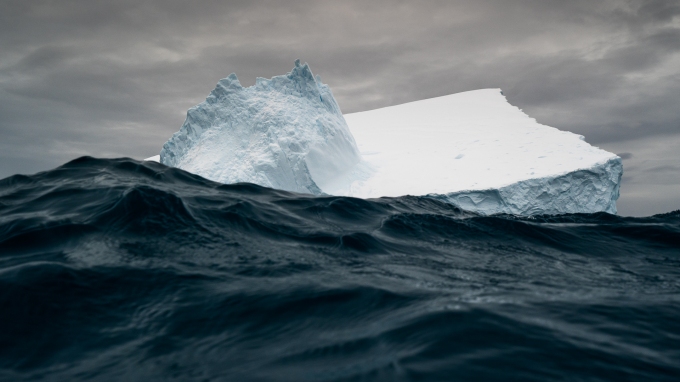
Low angel from a moving Zodiac with live view tilted screen. Sony A7iii with 16-35/4, 1/500 sec, f/ 7,1 @ ISO 400.
After I started shooting with the Sony I have started seeing new possibilities and I can’t wait to take it under water and also shoot low from our zodiacs and ships in the Arctic.
Other positives worth mentioning is the possibility to customize more or less every button on the camera. I especially like the option to save every exposure parameter to a custom button (I use the AEL button for this) so that I can quickly go from shooting fast shutterspeed to slow panning without rotating dials or going into the menu. Canon used to have this feature in the EOS 1D mkII but I don’t know if it still exists. I only wish I didn’t have to release the focus button for the custom settings to activate. Hopefully that can be solved with a firmware upgrade. This is also something I love about the Sony; with so few moving parts major adjustments to the camera performance can be done over regular firmware upgrades.

Black-browed albatross in the Drake passage. Sony A9 with 600/4, 1/60 sec, f/6,3 @ ISO100

Cape petrel in the Bransfield strait. Sony A9 with 70-200/2,8, 1/30 sec, f/7,1 @ ISO100
One of the most important features of any camera is of course the file produced. Both the cameras I have been shooting with have 24,2 megapixel sensors, and I consider this sufficient but nothing more. However, I hope to upgrade to the A9 II (same file size as A9) and also to get the A7r IV, which has an incredible 61,2 megapixel sensor! The one thing that struck me with the Sony files were the dynamic range in my images, and especially the details I got shooting backlit penguins. Shooting the birds on snow obviously helps as the light is bounced off the surroundings but even in harsh backlight I got amazing details in both shadow and highlight. I am really looking forward to seeing the files of the A7r IV when I get my hands on it.
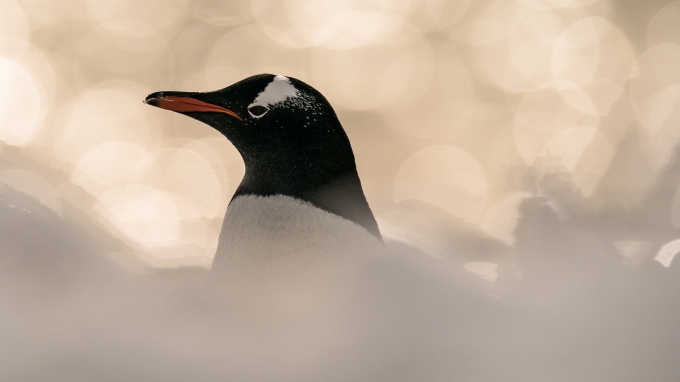
Gentoo penguin in harsh backlight. Sony A9 with 600/4, 1/8000 sec, f/5 @ ISO 200

Evening landing with Gentoo penguins. Sony A9 with 600/4, 1/2000 sec, f/4 @ ISO 100

After sunset Gentoo penguins. Sony A9 with 600/4, 1/1000 sec, f/4 @ ISO 100
On a couple of occasions I also got to use the insanely fast shutterspeed you can get with the A9. When shooting backlit penguins with the low sun in the frame I could shoot at 1/32000 sec, making it possible to still use a large aperture for a soft foreground and background. This is also extremely convenient when shooting with lenses like the 85/1,8 or similar.

Gentoo penguin enjoying the setting sun. Sony A9 with 600/4, 1/32000 sec, f/5 @ ISO 100
Even I haven’t really been using it yet I am also fascinated by the eye recognition feature, which will be upgraded to also work on animal eyes. I look forward to try it on Polar bears in the Arctic.

Unfortunately the animal eye focus will not include birds. Sony A9 with 600/4, 1/1600 sec, f/ 4 @ ISO 160
Negatives?
It has to be said, the menu system is a mess! I have always praised Nikon for having a simple and intuitive menu, unlike Canon, and I will stand by that. Sonys menu is extremely confusing and seem like it has been thrown into the camera on pure chance. Many of the menu options are also very hard to understand and the descriptions given by holding the trashcan button is just as confusing. Luckily you have the option of storing your own custom menu and I am sure that over time I will learn to use my custom menu and forget about the mess behind it.
It took a while for me to get used to the digital viewfinder but once I did I didn’t really think about it. The only thing I have learnt is that it takes a while for the camera to wake up after sleep mode. I have my cameras set to 1 minute before going into sleep mode and on more than one occasion I have put the camera to my eye only to realize the viewfinder is pitch black. When triggered it also takes a while for the viewfinder to wake up and even longer before the focus starts searching. I have lost images due to this and it is something I need to work around by changing the time before the camera goes to sleep or learn to wake it up while I am putting it to my eye.
Coming from the Nikon D5 and D850 I do find the button configuration of the A9 and the A7 III a bit odd. Especially wearing gloves it is very hard to work the dials and the buttons, but I have had the A9 II and also the A7r IV in my hands and I think the problems has been solved in this generation of bodies. The first time I held the A9 II it was almost like holding a Nikon D850 again, and with the grip I am sure it will fall into my hands quite nicely. In addition you get better weather sealing than you get with the A9.
A couple of things worth mentioning at the end is the lack of lossless compressed RAW which I hope can be solved over a firmware upgrade, and the dust issues which is more a hardware problem. The Sony sensor needs a lot of attention and I found that I needed to clean dust more often then I have ever done with my Nikons. However the sensor is large and easy to access and cleaning it is not too hard.
This is why
So to sum it up, I changed to Sony because I believe in innovation, a smarter future, awesome autofocus, a great lens line-up and okay the weight reduction is a bonus too. For me moving from Nikon to Sony felt natural in a digital world where a brand like Sony is a leading force. To bring photography forward the photographer and the camera brands have to work hand in hand, and at the moment I feel Sony is the brand that listens to the professional user. Together we can improve the art of photography.

Adelié penguin at dusk in Antarctica Nov. 2019. Sony A9 with 600/4, 1/640 sec, f/4 @ ISO 800.
Join me to Antarctica 2019
Posted on September 25, 2018

November 2019 I am leading a photography expedition to the Antarctic Peninsula with my fellow photographers at WildPhoto Travel. If you are interested in joining me on a once in a lifetime photography tour 1-14 November 2019 check out the details and book your spot on the WildPhoto website HERE!
Field test – AF-S NIKKOR 180-400 mm f/4E TC1.4 FL ED VR
Posted on April 24, 2018

The AF-S NIKKOR 180-400mm f/4E TC1.4 FL ED VR was tested in the Arctic winter on Svalbard.
Over the years as a Nikon ambassador I have been able to test a lot of new gear that has come out and some of it I have reported on, like the 200-500mm f/5,6 (https://roymangersnes.wordpress.com/2015/09/25/field-test-nikkor-200-500mm-f56e-ed/) and the 500mm f/4 (https://roymangersnes.wordpress.com/2015/07/28/field-test-nikon-500mm-f4e-fl-ed-vr/). After my contract with Nikon was terminated they still trusted me with new gear to test in collaboration with my partner Stavanger Foto (www.stavangerfoto.no), like the D850 (https://roymangersnes.wordpress.com/2017/09/26/field-test-nikon-d850-gone-wrong/). After the latest mishap with brand new equipment I wasn’t expecting to be testing anything for a while, but there I was hosting a 8 day winter expedition to the Norwegian Arctic archipelago Svalbard with my company WildPhoto Travel, testing a spanking new AF-S NIKKOR 180-400mm f/4E TC1.4 FL ED VR.
Test conditions
As before I don’t do technical analysis or in depth tests of all features. My main concern is – does it work for me in the field? After hosting over 20 boat expeditions for WildPhoto Travel (www.wildphoto.com) to Svalbard, and the last three years some in winter conditions, I knew that this was the perfect place to take this new lens to the test. During these trips we work on a moving ship in relatively low light, with temperatures sometimes dropping below minus 20 degrees Celsius. I normally bring a tripod, but on this tour I shot everything hand held. For reference I tried the lens with the Nikon D5, D850 and D500, with the D5 being my preferred body. During this expedition we had temperatures ranging from minus 5 to minus 20 degrees Celsius, with severe wind chill on some occasions. I left my photo equipment outside in the cold throughout the trip to prevent condensation issues. On the coldest days I did experience slowing down of the LCD screens but all other features of my cameras seemed to be working just perfectly, so it shouldn’t affect the performance of the lens.
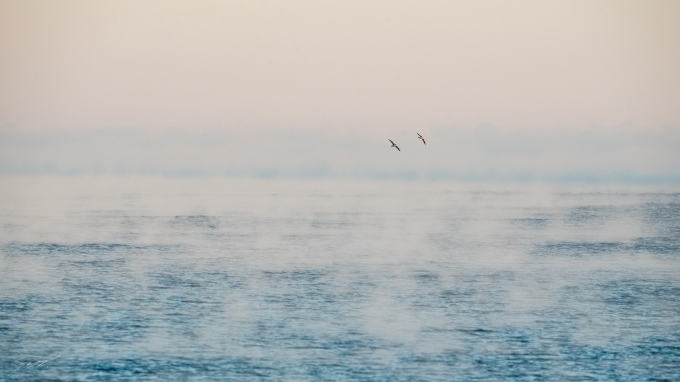
Fulmars over the mist an early morning, with temperatures dropping to -20 degrees Celsius. Nikon D5, 180-400mm f/4 @400mm, 1/800sec, f/8, ISO 1400
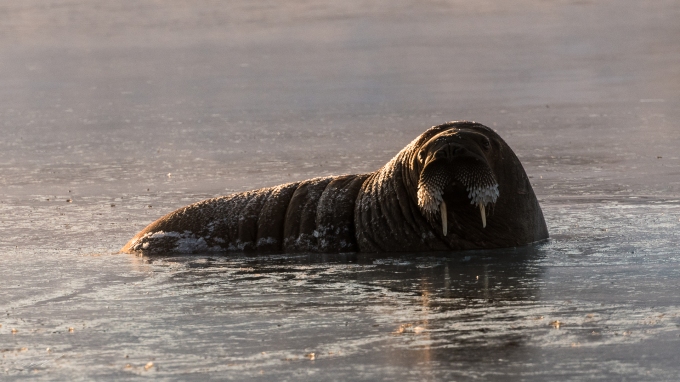
Walrus with icy whiskers. Nikon D500, 180-400mm f/4 @400mm, 1/2000sec, f/6,3, ISO 800
First impression
My first impression is that this is a solid built lens in the same category as my favourite 400mm f/2,8 and other prime Nikon lenses. Nikon say that the 180-400mm f/4E TC1.4 is built to replace the 200-400mm f/4. The way I see it this is something completely new! I never really liked the 200-400mm, but this lens is going in my bag.
The 180-400mm f/4E TC1.4 is relatively heavy (3,5kg), but there is a lot of good glass in this package. The lens features 1 fluorite and 8 extra-low-dispersion elements (ED glass) plus fluorine, Nano Crystal coatings. It is well balanced and feels really good with the D5, but even with the light D500 it is stable and comfortable in the hand. One thing that was bothering me with the 200-500mm was that you would have to turn the zoom ring very far to move from shortest to longest. This causes a lot of problems when shooting hand held because you will have to adjust your grip, but this is much better on the 180-400mm, and I believe it is well within what is acceptable. The new lens obviously also has an internal focus like the 200-400mm. In the future I would however love to see a servo on the lens, perhaps one you can turn on and off, that enables you to go from 180mm to 400mm with just a small adjustment of the zoom ring. At least the way I was using the lens; I rarely did fine adjustments to the focal length, but rather took if from 200mm to 350mm in one go. In such a case a servo would have been perfect. Anyway, that’s for the future.
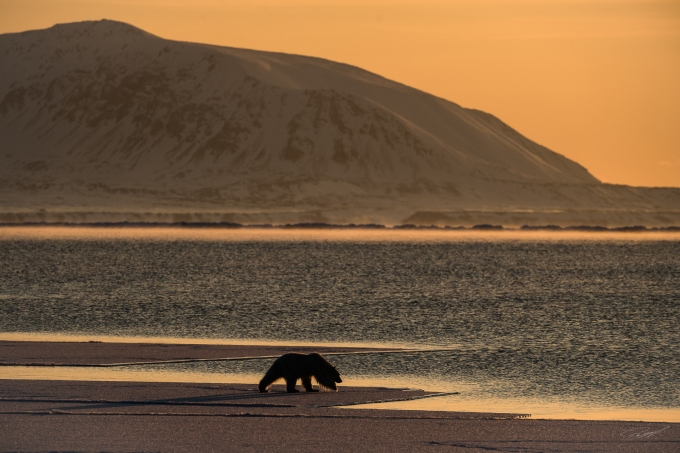
Young Polar bear at the ice edge in the late evening light. Nikon D5, 180-400mm f/4 @320mm, 1/1600sec, f/6,3, ISO 500
When it comes to use in the field there where several things I was curious to test. Sharpness obviously being one feature, but also focus speed, backlight, vibration stabilization and just how it handles was of importance. I was also curious to see how the built in extender performed and I must say I got used to it very quickly and it’s positioning seem to be good for my grip and hands. I can easily take it on and off while still shooting. It also seems the lens keeps focusing while you add the extender and also while adjusting the zoom. (Keep in mind that Nikon has a disclaimer saying you should not use the extender while focusing. I did this all the time, and didn’t have any issues.) There was an early problem with the 200-500mm where it stopped focusing when the zoom was used, but it does not seem to be an issue here. The problem mentioned was quickly solved with a firmware upgrade after it was pointed out by the first users.
To get the full potential of this lens, and your other lenses, make sure to have the latest firmware in your camera, including the Lens Distortion firmware.

Morning light and heavy clouds. Nikon D5, 180-400mm f/4 @460mm, 1/1000sec, f/6,3, ISO 140
Flexibility
The first point I want to make is about the flexibility that this lens gives me. On this expedition I brought the three bodies mentioned above, but limited my lenses to the 14-24mm f/2,8, 24-70mm f/2,8, 70-200mm f/2,8 and the 180-400mm f/4 TC14. My normal prime lens is the 400mm f/2,8 and I have also been using the 800mm f/5,6 on these expeditions previously.
For me photography is about telling stories and with this lens I can easily go from shooting close portraits and interaction to including the surrounding landscapes to add a sense of place and scale like I like to do, without having to bring another body and shorter lens. My 70-200mm f/2,8 was hardly used on this trip.

Polar bear portrait. Nikon D5, 180-400mm f/4 @450mm, 1/1250sec, f/8, ISO 1600

Polar bear jumping less than 30 seconds after the previous shot. Nikon D5, 180-400mm f/4 @290mm, 1/1250sec, f/8, ISO 1600
I also want to make a point about the close focus range, which is 2 meters (6.5′) at any focal length. This will make this lens a perfect lens for close up photography of critters like reptiles and butterflies, and also a very good portrait lens.
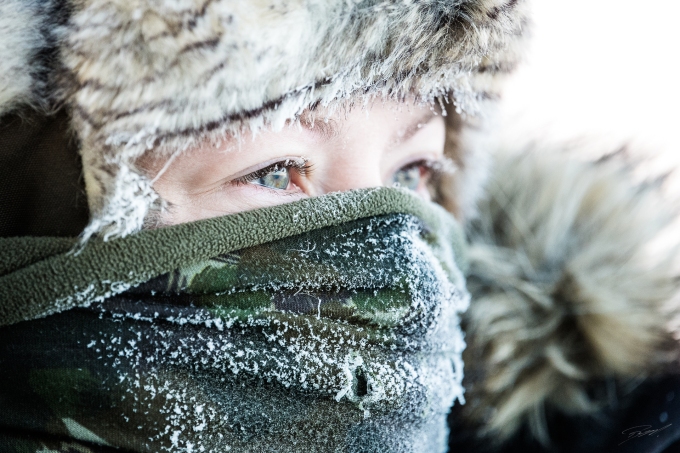
Close up portrait. Nikon D5, 180-400mm f/4 @330mm, 1/400sec, f/4, ISO 2500
The positioning and handling of the extender switch was a bit awkward in the beginning, probably also due to the fact I was working with thick gloves, but after a little while I was turning the extender on and off like a champion. It is very easy to use the ring finger on you right hand to operate the switch, and you can easily do this while your index and thumb is busy shooting (note the disclaimer mentioned above), and without taking your eye of the viewfinder. The switch feels stable and falls into place in a comfortable and natural way. I think the positioning of the switch is much more logic than the one found on the Canons equivalent lens, especially when hand holding.

Polar bear walking on ice edge in last light. Nikon D5, 180-400mm f/4 @290mm, 1/1250sec, f/10, ISO 1000
Sharpness
Like many wildlife photographers I am obsessed with lens sharpness, especially for my fine art work. I also have stock agencies that demand a certain level of technical quality in the files I submit. Now this is one of the reasons I never liked the 200-400mm f/4. I heard other people that where happy with it, so maybe I got a “Monday-lens”, but I honestly never felt it delivered the crisp files I was looking for. Therefore the 200-400mm spent most of its time at home when I was travelling.
On this tour I was mainly using the D5, but I also tested the lens on the D500, which is a slightly forgiving camera that also gives me another 1,5x reach, and also the not so forgiving D850. I was very pleased with the result even on the high resolution files produced by the latter.

Mountain side in blue hour. Nikon D850, 180-400mm f/4 @250mm (with 1,4 extender on), 1/800sec, f/8, ISO 640
The 180-400mm with its fluorite front element delivers high quality result, as you would expect from a camera giant like Nikon. Like the 200-500mm this new lens is sharp at both the extremes all the way to the corners. I did experience some vignetting on my shoot, but I did also shoot on a D5 with firmware version LD 2.015. When I updated the firmware to LD 2.017 the vignetting more or less disappeared. With the built in extender in use there is no vignetting visible anymore, and the sharpness is still very good.

Icebow over mountains at sunset. Nikon D5, 180-400mm f/4 @500mm, 1/1600sec, f/9, ISO 750
I must admit I was sceptical to a built in extender as it adds another element of glass, that’s even moving, but when it came to the field I found myself using it all the time. The optical quality of the lens with the extender in use is not as good as when its not use, as expected, but it is definitely good enough for my taste.
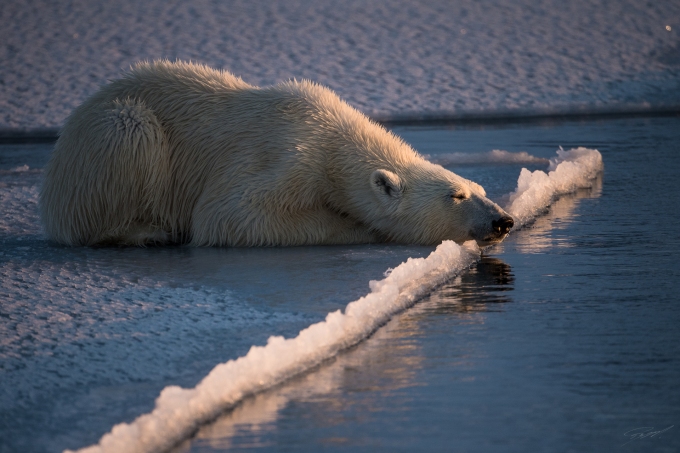
Resting Polar bear in late evening light. Nikon D5, 180-400mm f/4 @560mm, 1/1600sec, f/6,3, ISO 1000
Focus speed
During my Svalbard expedition in the beginning of April it was still early for most birds, but the Northern Fulmars where constantly following the ship. These are not the fastest of fliers but they toss and turn on the wind, close to the water surface below. When in addition the light was low and the ocean surface where covered by pancake ice it made for a challenging subject. Again the flexibility of this lens came into play as the birds come in towards the ship at changing distances, depending on the wind direction and wind speed. If there was a lot of wind they would come really close and I would fill the frame at 180mm, but sometimes I wanted to frame the bird against a beautiful background in the distance and needed the extra reach. With a small finger movement I would be able to switch the 1,4 extender on and shoot at the lens full reach to get my shot.
I tried different focus settings, like the Single point, Auto and my favourite Group Mode. I must say that the accuracy of the Auto settings keep surprising me, but with the contrasty ice on the ocean I found the Group Mode setting to be the best one. After shooting from the back deck for a while I found my groove and just like with my preferred 400mm f/2,8 lens I didn’t even bother checking my files as I was shooting – I just knew they where sharp!

Fulmar in flight over pancake ice. Nikon D5, 180-400mm f/4 @220mm, 1/1600sec, f/6,3, ISO 1000

Close up of Fulmar in flight. Nikon D5, 180-400mm f/4 @560mm, 1/1600sec, f/6,3, ISO 500
Backlight
Many people are afraid to shoot backlight, and always try to shoot with the light in an angle from behind to get “perfectly lit” subjects. With the dynamic range of the modern cameras you really shouldn’t worry. The backlight will give you a much more atmospheric image and you will still keep details in the subject. One of the challenges for many lenses when it comes to backlight is ghosting or flares. Nikon has developed lenses that has Nano Crystal coating that takes away most of this flare, but not all lenses has this. The new 180-400mm does. Therefore shooting backlight is no problem and the resulting images have close to no flare or ghosting.
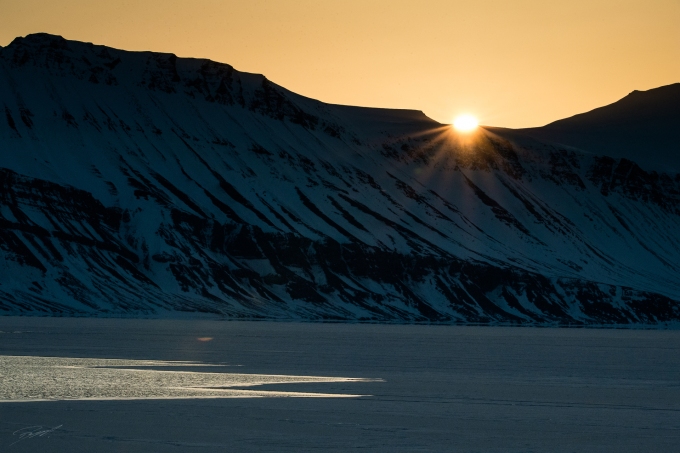
Morning sun. Nikon D5, 180-400mm f/4 @180mm, 1/1000sec, f/22, ISO 3200

Backlit Walrus. Nikon D5, 180-400mm f/4 @560mm, 1/2000sec, f/6,3, ISO 320
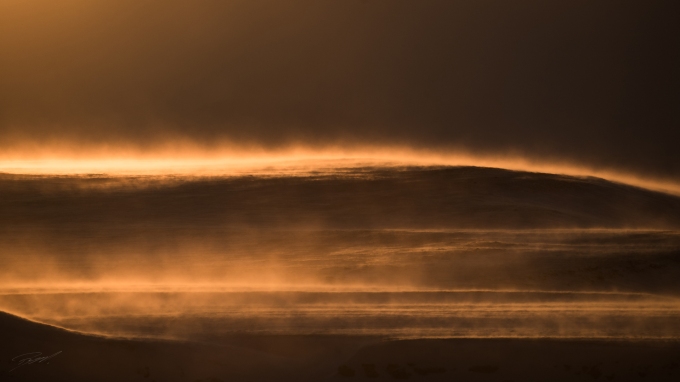
Snowdrift in backlight. Nikon D5, 180-400mm f/4 @560mm, 1/1600sec, f/7,1, ISO 180
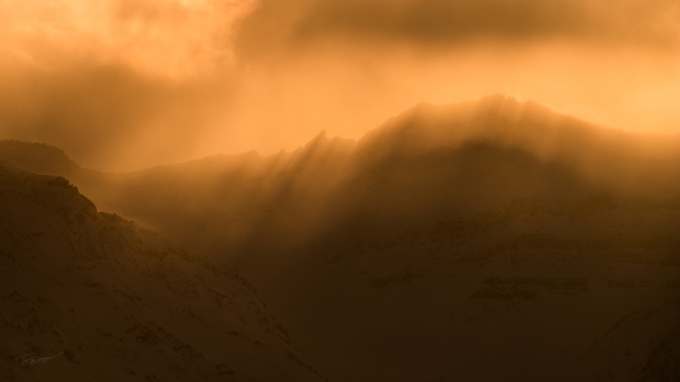
Snowdrift over mountain. Nikon D5, 180-400mm f/4 @560mm, 1/1250sec, f/9, ISO 250
Vibration Reduction
Over the years the Nikon Vibration Reduction technology has become better and better. According to some the new lens VR technology reduces camera shake equivalent to 4 stops. This is difficult to test in the field, especially as all my work was hand held from a more or less moving ship. All I can say is that it works for me in the conditions I was facing. My VR was constantly on during this shoot. On a couple of occasions I found myself shooting landscapes and Polar bears in late evening light at speeds down to 1/320sec, handheld with the 1,4 extender on. The ship was not moving at the time, but still… I also spent some time panning Fulmars flying next to the ship with speeds down to 1/30sec. I was using both Normal and Active mode on the lens VR, and in my experience Normal gives the best result in these panning situations, as recommended by Nikon support.

Early morning light, hand held from the ship. Nikon D5, 180-400mm f/4 @370mm, 1/400sec, f/5,6, ISO 800

Panned Fulmar in flight. Nikon D5, 180-400mm f/4 @270mm, 1/30sec, f/7,1, ISO 100
Conclusion
With the AF-S NIKKOR 180-400mm f/4E TC1.4 FL ED VR, Nikon hasn’t only got the lens with the longest name I have ever seen, but they have also brought out an extremely flexible tool that will produce superior images in a variety of situations. A client on my tour asked me what lens I would bring to future Svalbard expeditions with WildPhoto Travel if I could only choose one – my answer is the 180-400mm f/4E TC1.4.

The author in the field with the AF-S NIKKOR 180-400mm f/4E TC1.4 FL ED VR.
Field test – Nikon D850 (gone wrong…)
Posted on September 26, 2017
First of all I want to give a shout out to the best photography store in the world. The service found at my local pro store Stavanger Foto cannot be matched by anyone, and the knowledgeable people working there will always make you feel like their most important client. Check out www.stavangerfoto.no and give them a try, they deserve it!

Nikon D850, 24-70mm/2,8, 1/400 sec, f/5,6 at ISO1250 (converted to DNG from NEF and lightly edited in Lightroom)
OK, so now on to my Nikon D850 field test. I was very excited when I first read about the new Nikon D850 and I knew that this camera would be exactly what I had been waiting for. The larger file size is welcomed from a fine art perspective and in combination with a highly improved focus system, fast processors and better ISO capabilities I could easily see myself using this camera also for wildlife. Unfortunately Nikon have not been able to ship as many cameras as expected in the first batch and I was not able to get my hands on one before departing on a WildPhoto Travel photo tour to Alaska. That is when my local pro store, Stavanger Foto, stepped up and asked me if I would like to take their one and only demo camera with me to test in the field. Obviously they didn’t have to ask twice and arrangements where made so they would have it back in Norway as soon as I returned from Alaska, as I was travelling on to another assignment in Mexico and they needed the camera in store.
The Alaskan wild is a rewarding place for a wildlife photographer, but it is an unforgiving environment for fine technology, so this would be a perfect place to test the new camera. Like I have mentioned in previous field tests I prefer to try my cameras and lenses in the environment where I actually do most of my work rather then testing it in a lab or on a random location. For this field test I stayed 7 nights in a tented camp with only a portable solar panel for charging. For the first three solid days it was raining constantly before the weather cleared on the forth day. During those rainy days I used the Nikon D850 mainly as my short lens alternative, shooting with a 24-70mm/2,8E ED VR.

Nikon D850, 24-70mm/2,8, 1/250 sec, f/7,1 at ISO400 (converted to DNG from NEF and lightly edited in Lightroom)
Some of the features I very quickly recognized and enjoyed was the possible diagonal tilting of the LCD screen. This feature is very handy when shooting low to the ground, composing my images without the use of an angle viewfinder. I also noticed that the built in flash was removed, which I completely understand as it was a weak point in the previous models. During my 7 years as a Nikon ambassador (which I am not any more) I have been asking for the possibility to set the fn2 button to change between the different shooting bank menus without having to go into the menu system. Previously the response has been that the D800 and the D810 were not pro bodies and should not have the same features as the D4/D5. Finally it seems Nikon has acknowledged that the D800 series is the only professional option after the D3X was discontinued.

Nikon D850, 24-70mm/2,8, 1/25 sec, f/7,1 at ISO500 (converted to DNG from NEF and lightly edited in Lightroom)
During my test I did shoot with ISO way above what I would normally shoot with the D810, and closer to what I use on my D5, and the converted DNG files look amazing. The lack of noise and also the colour dynamics at high ISO is several levels above the previous models, and can easily be compared with the D5 if corrected for the larger file size. I also enjoyed the new focus system, also found in the D5. I am especially impressed with the Group focus, which I use a lot while tracking fast moving subjects, but recently I have also learnt to love the Auto AF mode. It is super fast and very intelligent. The frame rate is also impressive, considering the size of the sensor, with 7 fps, and a possible increase to 9 fps with the added MB-D18 battery grip.

Nikon D850, 24-70mm/2,8, 1/250 sec, f/4 at ISO2500 (converted to DNG from NEF and lightly edited in Lightroom)

Nikon D850, 24-70mm/2,8, 1/13 sec, f/2,8 at ISO8000 (converted to DNG from NEF and lightly edited in Lightroom)
As my preferred editing tool Adobe Lightroom has still not released an update for viewing and editing the D850 files I have not been able to review them properly, but from what I see so far the converted DNG files seem to have amazing dynamic range.

Nikon D850, 24-70mm/2,8, 1/320 sec, f/6,3 at ISO320 (converted to DNG from NEF and lightly edited in Lightroom)

Nikon D850, 24-70mm/2,8, 1/1600 sec, f/6,3 at ISO640 (converted to DNG from NEF and lightly edited in Lightroom)

Screen grab from Lightroom to show the dynamic range of the original NEF converted to DNG. No front filter (I often use Lee graded filters) was used on any of these images.
One feature I was really looking forward to test was how well this camera performs during night photography. The first night we had a clear sky I set up the camera on my tripod at the high water mark, and fitted it with the new Nikon 8-15mm lens. Being so far from civilization the entire Milky Way was visible and this night there was no moon so it was perfect for a test. I made use of the interval shooting option in the menu and found my frame to the west where the Milky Way would be most visible. I set my camera to take a picture every 15 minutes for five and a half hours starting at 23:00. My settings where 25 sec, f/4,5 at ISO3200. When all was ready I went to bed.
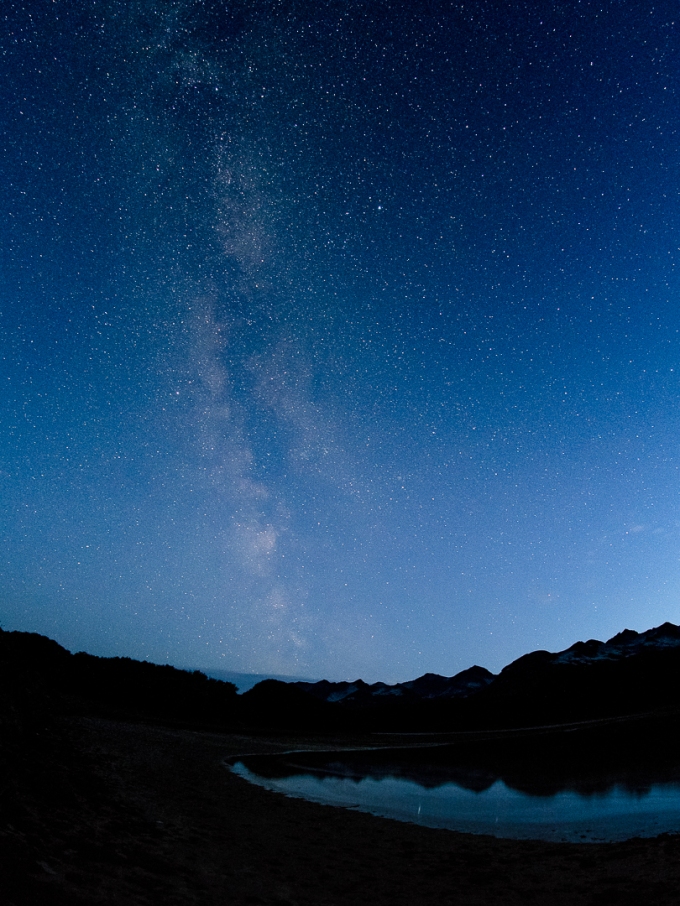
Nikon D850, 8-15mm/3,5-4,5, 25 sec, f/4,5 at ISO3200 (converted to DNG from NEF and lightly edited in Lightroom)
Next morning I came down to find wet grass on my camera thinking a bear came by to taste it. We did have bears around our tent regularly. The battery seemed to be empty, which was a surprise, but when I opened the chamber to change it reality hit my like a fist in the guts. During the night we had a record high, 13,7 feet tide and the entire camera setup had drowned!!! I just killed one of the very few Nikon D850 that was delivered in Norway and possibly the only one found in Alaska…

Nikon D850 – you will be missed…
There where so many more features that I was looking forward to test, but now it seems I will not get the opportunity. Based on what I did see, and also the few files that I have converted to DNG using Adobes converter, I am extremely impressed with this camera and I am sure I need one in my bag!
PS! Just to make it clear the Nikon D850 does come with a fully weather sealed construction, but it is not a underwater camera…
FIELD TEST – NIKKOR 200-500mm f/5,6E ED
Posted on September 25, 2015
Due to efficient logistics and a good friend I was lucky to receive the new Nikkor 200-500mm f/5,6 lens a couple of days after I arrived in the Arctic. The next morning, September 14th, I embarked on a 10 days photographic expedition around the Svalbard archipelago. Like many times before I was hosting photographers from around the world to this magical destination on top of the world for our travel company WildPhoto Travel. I was really looking forward to using the new lens in these conditions and my expectations were very high. I realize the 200-500mm lens is not competing in the same league as my preferred long lens, the 400mm 2,8, or other high-end lenses from Nikon, but I was expecting it to perform just as good as the competing brands with equivalent zoom ranges.
The entire test was done using the 200-500mm lens together with the Nikon D4s handheld.
SPECS
According to the official Nikon website “the AF-S NIKKOR 200-500mm f/5.6E ED VR is a 2.5x super-telephoto zoom lens that supports the 200-500 mm range of focal lengths with a maximum aperture of f/5.6. Adoption of ED glass elements achieves superior optical performance with which chromatic aberration is suppressed.
In addition, the lens is equipped with a vibration reduction (VR) function that exhibits the highest level of camera shake compensation available with a NIKKOR lens—equivalent to a 4.5-stop increase in shutter speed”
So how does it work in the field?
FIRST IMPRESSION
At first I was taken by the size of the lens. Obviously being a 5,6 aperture lens it was rather compact and light weight (2,09kg). Still it feels like a really solid built lens. I am usually a bit worried about zoom lenses with external zoom as they have a tendency to suck in dust and moisture. I did however not experience any of this even though I was shooting in moist weather and temperatures fluctuating around zero degrees, producing a lot of condensation. I have previously been surprised by the Nikkor 28-300 f/3,5-5,6 lens, and how it could withstand fine sand from the Kalahari and also moisture in the Bolivian rainforest. The 200-500mm seem to have been constructed in a similar way.
The lens feels a little heavy towards the front when zooming all the way out to 500mm, even when shooting with a Nikon D4s body. However, the over all light weight of the lens makes it easy to handle and I did find the range to be very handy for the situations I encountered.
Shooting from a moving ship or a Zodiac rubber dingy it was very useful to be able to adjust the framing without the need to alter the position of the boats. Especially in situations when the subject suddenly changes behaviour and we had interaction is was great to be able to get a wider frame and include the action or the landscape.
OPTICAL QUALITY
Obviously the optical quality of the lens is extremely important and it was the first thing I wanted to test. If the lens did not perform to my expectations I would most likely not use it in many situations during the trip, as I would have hated to miss shots because of bad optics. I was happy to see that the lens was very sharp throughout the range. As a matter of fact I could not see any difference in the sharpness though the zoom range. During the next 10 days I would shoot roughly 2000 frames with the lens, capturing subjects like Polar bear, Walrus, Arctic birds, icebergs and landscapes. I had no second thoughts about choosing the 200-500 as my preferred lens in most situations.
I was also very happy to see that the lens preformed well in the whole focal range available. Many zoom lenses struggle at the extremes, but I could not see any changes when shooting at 500 or 200 compared to other focal lengths.
The only situations I turned to my 400mm f/2,8 was when shooting backlit subjects or in low light. Obviously the extra stops gained with an f/2,8 lens did come in handy when the light was low. When it came to backlight, the lens handled most situations well, but with a lot of ice and reflections I did experience some flare that I usually don’t see in my prime lenses with nano-coating.
However, it is worth noting that the 200-500mm does handle harsh light very well and I did get very little chromatic aberration, if any at all. This is very impressive considering the pricing and built of this lens.
FOCUSING
The 200-500mm is not your typical action photography lens with an aperture of 5,6, but for most of the stuff I was shooting on this trip it worked quit well. Most of the time I find myself stopping down to 5,6 and 8 when shooting wildlife anyway, and with the ISO capabilities of the cameras today I have no problem with a 5,6 lens for action.
There was however a tendency for the lens to perform slower in low light and I struggled to follow the birds after the sun had set, especially when they were flying over the ocean surface. Not an easy autofocus situation for any lens, but my experience with the 400 f/2,8, and other prime lenses, is that it should be possible. Group-AF was used for all the action shots. That being said, in “normal” light situations the lens performed very well and I was able to produce some images I did not expect to get with this kind of zoom lens.

Northern Fulmar against the Spitsbergen mountains in evening light – Nikon D4s, 200-500mm @ 500mm, 1/640sec, f/7,1 and ISO 1250
During the trip I was shooting a lot of backlit wildlife and I was surprised by the performance of the focus in these situations. The Group AF mode was following the subject with ease and the sharpness was beyond expectation.
The VR was also impressive and as I was shooting everything handheld, or resting on a moving Zodiac I was really testing the VR to the limit. Even in a moving Zodiac I was able to produce sharp images with the lens at 500mm and a shutterspeed of only 1/200 second. That is very impressive!
I left the VR on most of the time, except when panning at 1/40 sec or slower. I was not able to conclude on how the VR works while panning, but I did experience some ghosting when it was active at this speed and slower. This usually also appears when shooting with prime lenses.
CONCLUSION – GOOD AND BAD
To conclude I can say I would be happy to have this lens in my bag, and I find it extremely handy for many situations. When shooting from a fixed position like a safari vehicle or a hide the zoom is perfect. I also find the range from 200mm to 500mm sufficient for this kind of lens. I have requested this for some time, actually since Canon released the 200-400mm with built in 1,4 extender. I couldn’t see why they didn’t just produce a 200-560mm for that matter and make it a 5,6. Now it seems Nikon have followed my thoughts and produced a great zoom lens at a great price!
+ : Light weight, solid built, handy range, super sharp, precise focus, impressive VR and good price.
– : Slightly off balance at 500mm, flare when shooting backlight and a little slow in low light.
I will recommend this lens to many!
Thanks to Nikon Norway for lending me the lens on our expedition to the Arctic.
Field test – NIKON 500mm f/4E FL ED VR
Posted on July 28, 2015
First impressions
The 500mm f/4 was my preferred telephoto lens for many years. I was using the Nikon one between 2008 and 2013 before switching to the 400mm f/2,8. As a wildlife photographer I have always appreciated the versatility of the 500mm compared to the more specialised 600mm. I also enjoyed the slightly lighter weight of my lens compared with colleagues dragging around the “monstrous” 600 f/4. Now it seems things have changed.
As of July 2nd Nikon announced the release of both a new AF-S NIKKOR 500mm f/4E FL ED VR and AF-S NIKKOR 600mm f/4E FL ED VR. My WildPhoto Travel colleague Ole Jørgen Liodden was lucky to test a beta version of the 600mm for Nikon already in April (read his test here; http://oleliodden.com/tech-tips/test-report-nikon-600/) In July I was asked by Nikon to test the 500mm lens under normal working conditions. Unfortunately I was already on my way out on a Svalbard expedition and was not able to bring the new lens, but as soon as I returned home I took it out for a spin. Here are my first impressions.
I haven’t had much time with the lens but I have been out twice in different conditions to see how it performs, and also done some simple comparisons with my other lenses close to home. In total I have taken 900 images with this lens over a couple of days, both handheld, on a tripod, resting on the ground and also from a moving boat.
The biggest difference between the old and the new 500mm is very evident as soon as you pick it up from the box. Yes, there is a new hard case, but that’s not it… I knew the lens was lighter, but still I was caught by surprise when I held it in my hands. The 20 % difference in weight is a welcome change in Nikon lenses. I know some wildlife photographers have moved from Nikon to Canon due to their range of light weight lenses – now is the time to move back.
Also, the lens have been redesigned and the weight has been shifted slightly to the back making the 500mm better balanced with my D4s, and easier to hand hold. Even with the D810 attached it feels good holding it.
Nikon is one of the most respected brands in the world and would not release a new lens that do not deliver at least as good as the previous, so I was not surprised by the overall performance of the lens. I did test it in my back yard against my trusted 400mm f/2.8E FL ED VR, and I still believe my 400mm is sharper then the 500mm but I do not have a lot of hard evidence to prove it.
In the field
For years Nikon telephoto lenses have been superior to the competition when it comes to shooting backlight and in harsh conditions. The combination of extra-low dispersion glass (ED) and nano-crystal coating has given them a huge advantage. The new 500mm has no less then 3 ED lenses and is obviously treated with nano-crystal coating. Flare and chromatic aberration is therefore kept at a minimum.
During my first shoot I was working in quite harsh backlight. I was shooting wetland birds and used a dark forest as my background and wet vegetation as my foreground. Nine rounded shutter blades gave a nice bokeh and also nice rounded reflections in the wet foreground. It does seem the reflections fall a bit to the edges, compared to my 400mm, but I was still very happy with the result.
Second day I was shooting White-tailed Eagles, and a lost Northern Gannet that came by, from a moving boat. The light wasn’t great but this is a classic wildlife photography situation and I have been shooting with the previous 500mm lens many times before. That being said I haven’t used the old 500mm together with the D4s, but rather D3, D3s and D4.
During a 3-4 hour outing I fired over 500 frames using mostly Manual mode (M) and fast shutterspeed. I also did some panning with shutter priority (S) at between 1/30 and 1/60 sec. I used the lens with VR off most of the time. I could not see any difference with the VR on or off during this shoot. I also used the amazing Group AF Mode on the D4s with lock-on at “Normal”. This is my standard setting for most flight photography and I am super happy with the performance. ISO level was averaging around 1250.
As usual (I am no trying to brag…) almost all my eagle shots were sharp. I did clip a wing or two and also locked on the tail or claws on a few occasions (once on the background…), but the focus speed was more than sufficient to track the diving raptor. So as long as you keep the subject in the frame it should be able to track it.
As for panning I pretty much used the same technique as always and the result was as expected. I know my WildPhoto Travel colleague Liodden did find a big difference in the ghosting effect when panning with VR on Sport-mode, with the new 600mm being a lot better than the previous version. Unfortunately I did not find this with the 500mm. Shooting flying birds at 1/30 second is obviously a game of luck (and some skill) and I did not shoot more then 3-4 series with this technique. I did nail a few shots but I cannot claim the result was better then I normally would get. I should probably go out and try again.

White-tailed Eagle panned against the forest background – Nikon D4s, 500mm f/4E, 1/40sec, f/6,3 @ ISO 50

White-tailed Eagle panned while taking off with catch – Nikon D4s, 500mm f/4E, 1/30sec, f/13 @ ISO 50
One thing worth mentioning though is the fact that I was shooting effortlessly handheld all this time and I could move the lens around more or less without any strain. The new 500mm f/4E is a dream come true for any wildlife photographer shooting handheld and also dragging gear around the mountains.
I will probably still keep to my 400 f/2,8, as it suits my use better, but I expect to see several new 500mm lenses in the field in the near future.
Thanks to Dag and William Brynjelsen for taking me out to the eagles. Check out young Williams images HERE – a talented kid.
DSLR movie from Mosvatnet
Posted on February 19, 2015
Since March 2014 I have been working on a nature production about the amazing Mosvatnet recreational area in Stavanger. My goal has been to document the amazing natural diversity found within the boarders of the fourth biggest city in Norway. The tracks around this lake is used by several hundred thousand people every year, on their way to work, exercise and for recreational purposes. The lake and the surrounding nature/park area is also under extreme pressure from development, management plans and pollution. My hope is that this film can add some knowledge about the amazing natural habitat we have this close to Stavanger, and hopefully we can make sure it will be protected for future generations.
The film was produced as an assignment for the Norwegian Conservation Organization (Rogaland) and Mostun Natursenter.
The entire film was made entirely on Nikon DSLR cameras (D4, D4s and D810) and prime Nikon lenses (16-35mm, 24-70mm, 70-200mm and 200-400mm).
Click image below to see the film on Youtube (make sure to select HD)
Nikon D810 first impression
Posted on November 10, 2014

Nikon D810, 70-200mm, 1/10 sec @ f/11 and ISO 64 / Lee filters
Repost from blogspot
As a Nikon ambassador in Norway I was happy to receive the new D810 one week before it was released on the public market. The same evening I went out and gave it a go in the bird cliffs outside Longyearbyen, Svalbard. I made a summary of my first impression with this camera and also a slideshow (from jpegs) and posted it on youtube. To see my first hand field review of the Nikon D810 go to this link; http://youtu.be/Yf-q2frVvvg
After the initial impression from July I have been using this camera a lot, and especially for DSLR video. The quality of the files, both stills and video, is still mind-blowing and I am certain there is no camera like it on the market today!
Photographer giving back
Posted on November 8, 2014

In English below
I 2009 startet jeg et prosjekt i Bolivia i samarbeid med den ideelle organisasjonen Boliviafamilien. Denne er lokalisert i Sandnes i Rogaland, men har siden den spede starten i 1981 bygget opp 5 barnehjem og 19 dagsenter som til sammen gir over 1000 barn et trygt alternativ i et av Sør-Amerikas fattigste land.
Min opprinnelig plan var ambisiøs, men på grunn av uventede vendinger i min karriere ble jeg nødt til å kansellere prosjektet etter to lengre reiser i dette mangfoldige landet. Som en takk for den hjelpen jeg fikk av Bolivifamilien og de båndene jeg knyttet til Bolivia har jeg bestemt meg for å gi tilbake på den eneste passende måten.
I løpet av november og desember i år vil jeg tilby 10 utvalgte bilder fra Bolivias mangfoldige natur som Fine Art print i et begrenset opplag og til en svært redusert pris. Jeg håper at dette kan generere salg slik at jeg kan gi noe tilbake til Boliviafamiliens barn.
Bildene som tilbys vil bli printet som Fine Art print på Epson Hot Press papir i A3 størrelse uten ramme. De vil bli signert og nummeret 1-30 for hvert motiv.
Prisen på bildet vil være 1500.- der 500.- vil dekke kostnader med produksjonen og logistikk. Resterende 1000.- vil gå direkte til Bolivias barn. Porto vil komme i tillegg.
Finn ditt favorittbilde under og ta kontakt nå for å sikre deg et bildet i begrenset opplag før jul!
En stor takk rettes for øvrig til Stavanger Foto og Rammehjørnet for hjelp med produksjon av salgsutstillingen.
_____________________________________________________________________________________________________________
In 2009 I started a project in Bolivia in collaboration with the Norwegian NGO Boliviafamilien. This organisation is located in Sandnes, Norway but is running 5 children’s homes and nineteen day care centres, offering a safe alternative for more then 1000 children in need.
My initial plan was a grand one, but due to unexpected turns in my career I had to abort after two trips to this magnificent country. As a token of my appreciation for the help I got from Boliviafamilien and also the connection I got with the people of Bolivia I have decided to give back in the only way I see appropriate.
During a period of two months I will offer 10 of my images from the diverse nature of Bolivia as limited edition Fine Art prints to a very reduced price. I hope this will generate sales so I can give something back to the children under care of Boliviafamilien.
The images offered will be printed on Epson Hot Press paper in A3 size only, signed and numbered in a series of 30 each. The prints will not be framed.
The price will be 1500NOK, where 500NOK will be covering the cost of production and logistics. The remaining 1000NOK will go directly to the children of Bolivia. Shipping cost will be added.
Find your preferred image below and order now to get it before Christmas!
#001

#002

#003

#004

#005

#006

#007

#008

#009

#010

 Roy Mangersnes photography
Roy Mangersnes photography

